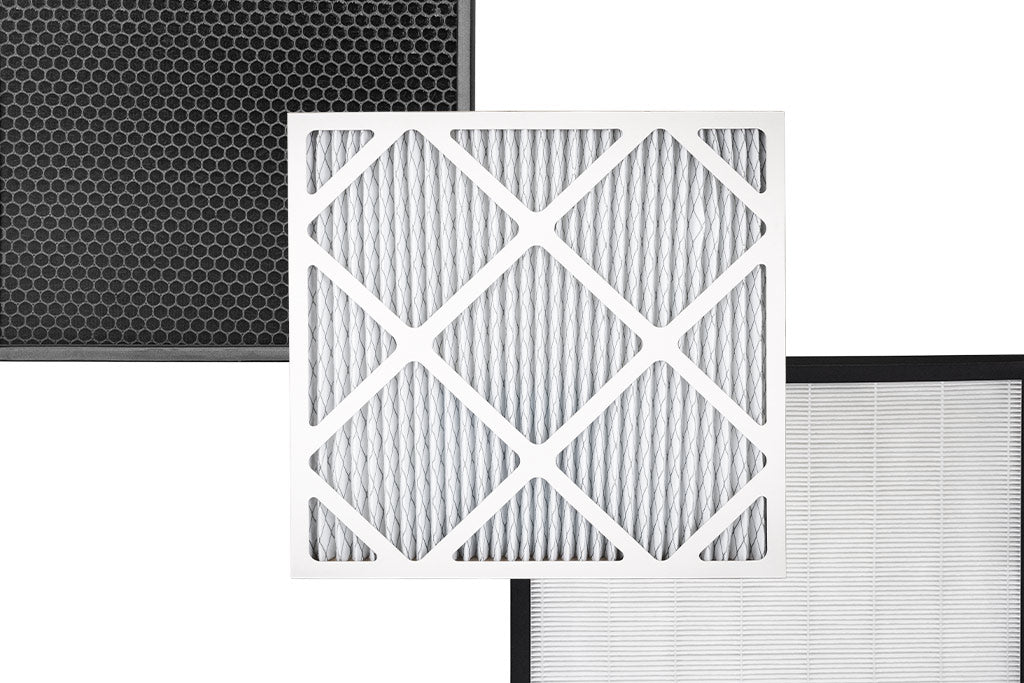What do you think of when you hear the word ‘pollution?’ Trash in the city park? Oil floating atop the ocean? While those examples are usually what pops into people’s minds, air pollution is an equally important concern that can have very real health impacts on people. Adding outside sources like recent raging wildfires, you might be thinking about ways to improve IAQ (indoor air quality) at home or work for the health and well-being of yourself and those around you.
Air purifiers are a great way to combat bad air quality. Looking online, you’ll be met with tons and tons of air purifier options. Some are portable, some are installed with your HVAC system, some are single stage, others are multi-stage. There’s a jumble of jargon and numbers related to the filters they contain. But, what exactly do those numbers mean, and what does each filter do? Let’s break down a few things about filters and their performance when used with air purifiers.
How is a HEPA filter different from a standard filter?
A HEPA (High Efficiency Particulate Air) filter is an extremely dense pleated filter composed of interlaced glass threads in a fibrous mat. According to the EPA, a HEPA filter “can theoretically remove at least 99.97% of...airborne particles with a size of 0.3 microns (µm).”
It’s no wonder HEPA filters are used in a wide variety of residential and commercial applications. Due to their nature, HEPA filters can be one of the most expensive filters to replace – look for an air purifier which uses a HEPA filter in conjunction with a pre-filter, or that has multiple filtration steps, to trap larger debris before reaching the HEPA filter. Doing so will likely mean your HEPA filter will be on a longer recommended replacement schedule than it would be if used on it’s own, giving your wallet a break with fewer replacements during the year!
A micron? What's a micron?
Ok, so a HEPA filter can remove particles down to 0.3 microns. But just how small is 0.3 microns (µm), and what the heck is a micron? A micron is a form of measurement used for extremely small particles—literally one millionth of a meter. Take a look at this chart from Visual Capitalist to see just how small some familiar particles measure up.

Guide showing just how small some familiar particles can be, measured in microns, from Visual Capitalist.
Is an activated carbon filter important?
When is a carbon filter right for you? If you have an area with cooking odors, pet odors, or smoking, look for a unit with an activated carbon filter to refresh your space.
Unlike fibrous filters, which are designed to remove particles from the air, an activated carbon filter’s job is to focus on filtering out gaseous pollutants like odors and smoke. Porous charcoal inside the filter traps molecules as the air moves through in a process called adsorption. Think of the carbon a little like tape – as pollutants pass by, they become stuck to the outside of the carbon’s surface. However, just like tape, once something’s been stuck there, nothing else can stick on top. When all the binding sites have been filled, the carbon can no longer work to trap any more pollutants, which is why it’s important to change or clean it on a regular schedule according to the manufacturer’s instructions.
What is MERV?
MERV stands for Minimum Efficiency Reporting Values, and rates the filter’s performance and efficiency when capturing particles of varying sizes.
Typically you’ll see MERV ranging from 1 – 16, although they can go higher for more specialized applications, like hospital use. The higher the number, the more efficient the filter is at capturing smaller and smaller particles. As an air purifier pulls air in, particles suspended in the air also follow and become trapped in the filter’s fibers.
For our portable air purifier unit, the AS1000WHT’s pre-filter has a MERV 9 rating, making it the first stage out of 3 filtration steps, and first defense against large particulates in the air. For MERV 9, this includes dust, lint, fibers, and other debris which can range from 3 – 10 microns in size.
Other manufacturers may use pre-filters with a MERV rating that is higher or lower than this, or may use only a single filter without a pre-filter or multiple filtration steps, so it's important to understand the unique challenges in your space and how each filter type or rating will benefit you.
When I need to replace my filter, should I just replace it with the highest-rated MERV filter I can find?
In short, no. A higher MERV rating is not always better—higher MERV values also mean a more dense filter, which can impact airflow and can strain the machine it’s installed in if the unit is not designed to handle that rating. It's a balancing act between filtration level and airflow, so only use the filter rating recommended by the air purifier manufacturer to ensure your unit operates safely and as intended.
--
No matter what type of system you use, it’s important to note that no air purifier will completely remove all of the contaminants in your space. To keep any air purifier operating at it’s best, remember to regularly clean your unit and/or replace your filters according to the manufacturer’s instructions.
Have more questions? We’re always here to help! Feel free to contact us for more information.

